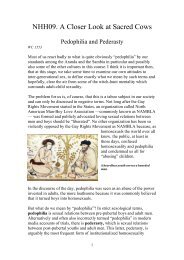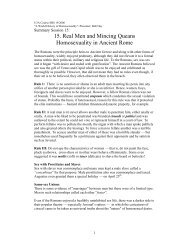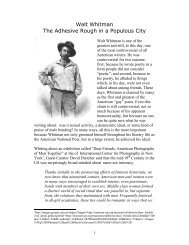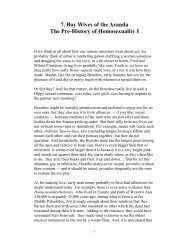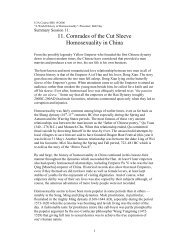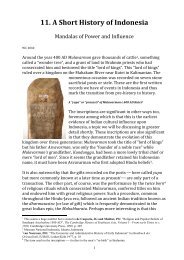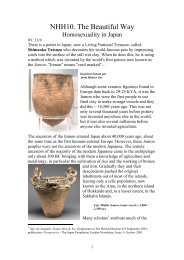10. The Beautiful Way Homosexuality in Japan
10. The Beautiful Way Homosexuality in Japan
10. The Beautiful Way Homosexuality in Japan
You also want an ePaper? Increase the reach of your titles
YUMPU automatically turns print PDFs into web optimized ePapers that Google loves.
especially for women fasc<strong>in</strong>ated by the “boy-love” theme, a genre<br />
<strong>in</strong>creas<strong>in</strong>gly written and drawn by women themselves.<br />
However, I would describe the romantic and sexual relationships<br />
<strong>in</strong> these stories as 'homosexual' deploy<strong>in</strong>g the <strong>in</strong>verted commas to<br />
show that what is be<strong>in</strong>g described here is a very specific<br />
construction or, better, 'fantasy' of what male homosexual love<br />
means. Not only are the male characters not supposed to represent<br />
'gay men,' they do not really represent 'men' either, <strong>in</strong> that they are<br />
referred to as bishoonen or 'beautiful boys/youths.' <strong>The</strong>y are drawn<br />
<strong>in</strong> such a way as to suggest an androgynous ideal: they have tall,<br />
slender bodies, high cheek bones and po<strong>in</strong>ted ch<strong>in</strong>s, wide eyes and<br />
long flow<strong>in</strong>g hair. Also, they behave <strong>in</strong> a rather 'fem<strong>in</strong><strong>in</strong>e' manner,<br />
express<strong>in</strong>g the emotionality and vulnerability often associated with<br />
female characters <strong>in</strong> more ma<strong>in</strong>stream fiction.<br />
Various commentators have, then, argued that the bishoonen are<br />
not really 'men' but fantastic, androgynous creatures created by<br />
<strong>Japan</strong>ese women as an expression of dissatisfaction with current<br />
gender stereotypes and the 'narrow life paths' which restrict<br />
women <strong>in</strong> the real world. 13<br />
Despite the plethora of images of homosexual men <strong>in</strong> the women’s<br />
media, men themselves seem to be relatively unaffected by them. Many<br />
regard these as figments of women’s imag<strong>in</strong>ation, ideals of beauty which<br />
would be unatta<strong>in</strong>able <strong>in</strong> real life.<br />
However, there is evidence that these notions are more than just daydreams<br />
for many women. As McLelland reports,<br />
Start<strong>in</strong>g with a series of articles <strong>in</strong> the women's magaz<strong>in</strong>e CREA <strong>in</strong><br />
February 1991, entitled 'Gay Renaissance,' <strong>Japan</strong>ese women's<br />
media began to <strong>in</strong>terest themselves <strong>in</strong> <strong>Japan</strong>'s gay subculture<br />
which resulted <strong>in</strong> what has s<strong>in</strong>ce been termed <strong>Japan</strong>'s 'gay<br />
boom’…. One article <strong>in</strong> CREA under the headl<strong>in</strong>e of 'Women who<br />
plan on spend<strong>in</strong>g a pleasurable life with gays' expla<strong>in</strong>s that<br />
women's <strong>in</strong>terest <strong>in</strong> develop<strong>in</strong>g not just friendships with gay men,<br />
but cohabit<strong>in</strong>g relationships, results from the negative image they<br />
have of traditional mascul<strong>in</strong>ity and mascul<strong>in</strong>e roles. In this article,<br />
and others like it, it is assumed that gay men are radically different<br />
from their straight counterparts and can even be 'best partners'<br />
[besuto paatonaa] for women. Ma<strong>in</strong>stream magaz<strong>in</strong>es such as the<br />
tabloid-style SPA (18 March 1998) have also picked up on this<br />
13 McLelland, ibid.<br />
13



